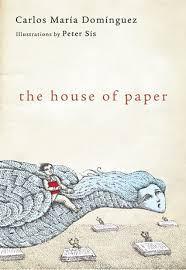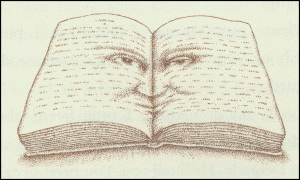The House of Paper, by Carlos Maria Dominguez and translated by Peter Sis
There are some terms I never use to describe books. Important for example. If it’s not a major sacred text or Das Kapital then however good it may be it’s probably not that important. Life-changing is another. How exactly did your life measurably differ after reading a supposedly life-changing book?
But perhaps I’m wrong. Here’s the first paragraph of House:
One day in the spring of 1998, Bluma Lennon bought a second-hand copy of Emily Dickinson’s poems in a bookshop in Soho, and as she reached the second poem on the first street corner, she was knocked down by a car.
As the author reflects, ‘Books change people’s destinies.’

House is a charming novella about the dangers inherent in books. The more obvious perils are the physical ones: the risks inherent in volumes stored on high shelves where you can overbalance reaching for them or have them fall on your head. Beyond that though the real dangers are subtler.
Bluma was a Cambridge academic and a little while after her death the unnamed narrator is appointed as her replacement. It’s because of that he receives a late piece of post for her – a parcel containing a broken-spined copy of Joseph Conrad’s The Shadow Line. Bluma was writing a thesis on Joseph Conrad at the time she died which could perhaps explain why someone sent her it:
But the extraordinary thing was that there was a filthy crust on its front and back covers. There was a film of cement particles on the page edges that left a fine dust on the surface of the polished desk.
There’s no note and no explanation, just an inscription from a “Carlos”. For no evident reason this Carlos sent Bluma a terribly damaged copy of an easily obtained book. It even appears to have been dipped in concrete at some point. Why was she sent it?
The narrator can’t leave the question alone. He is an avid reader and collector. His house is filled with books, each well cared for. He owns nothing like this battered orphan volume. It’s presence sparks reflection on books and his relationship with them:
There is a moment, however, when we have accumulated so many books that they cross an invisible line, and what was once a source of pride becomes a burden, because from now on space will always be a problem.
So true. Worse yet he thinks about:
… the panic I feel when someone praises all the books I possess. Every year I give away at least fifty of them to my students, yet I still cannot avoid putting in another double row of shelves, the books are advancing silently, innocently through my house. There is no way I can stop them.
What’s to be done? He can’t bring himself to just bin the rogue Conrad but nor can he ignore it. He sets off to Uruguay where the parcel came from to investigate the sender and discover his story.
In Uruguay the narrator meets other book collectors and through them learns about Carlos, who died himself not long after posting the Conrad. Carlos was also a collector and owned more than twenty thousand titles. That meant he was faced with the classic problem of how to keep track of them all and how to be sure of finding any particular book quickly and easily.
Carlos took the view that indexing by alphabetical order or by theme leads to absurdities. He was sure that a better method was possible – a perfect indexing methodology based on the affinities of the texts in question. Those affinities were clear only to him, although he does explain to his friends that at the very minimum one cannot sensibly shelve together books by writers who don’t get along: as Carlos explained Amis cannot be anywhere near McEwan following their famous falling-out.
Books are seductive. Carlos liked to read 19th Century novels by candlelight, would pour a second glass of wine for the book he reads at dinner. One guest sees on Carlos’s bed a pile of books which:
reproduced the mass and outline of a human body. He swears he could see the head, surrounded by small red-backed books, the body, the shape of arms and legs.
Books can bring madness. I won’t say much more as this is a fairly easy single-sitting read and much of the pleasure of it lies in discovering quite how Carlos was brought down by his collection and the reason for the curious delivery of the concreted Conrad.
I thoroughly enjoyed The Paper House. It comes with bookish illustrations that don’t particularly relate to the text but which are lovely and therefore need no other justification. It’s something of a cautionary tale and literary joke and that means it’s a bit slight, but that slightness is also what makes it such a fun read.

House is perfect for the younger reader in your life who may have caught the book bug but who it may still be possible to deter. A gift of House could provide a useful warning, allowing them to take up a healthier pastime such as hang-gliding or professional ice hockey. For the habitual reader it’s probably already too late, but there will at least be a twinge of pained recognition.
Other reviews
Guy Savage reviewed this here and it was his review which prompted me to buy it. On the more negative side, I discussed it on Twitter with Scott Pack who has read it twice and found afterwards that he could remember almost nothing of it either time. Although I’m with Guy on this one I’m not entirely surprised it might not stick in memory – it’s in its nature as a relatively light comic anecdote that it’s not going to stick the way say Krasznahorkai’s Satantango might.
Filed under: Novellas, South-American fiction, Spanish, Uruguayan fiction Tagged: Carlos Maria Dominguez

